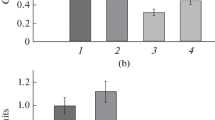Abstract
Prolonged transcutaneous irradiation with helium-neon laser light decreases the transport ability of the popliteal and iliac lymph nodes. Laser radiation stimulates lymphocytes, predominantly T cells.
Similar content being viewed by others
References
K. B. Abzaliev,Morphofunctional Characterization of the Inguinal Lymph Nodes After Laser Irradiation, Author’s Synopsis of PhD Thesis [in Russian], Alma-Ata (1993).
I. M. Baibekov, A. Kh. Kasymov, V. I. Kozlov, and E. Sh. Musaev,Morphological Basis of Laser Therapy [in Russian], Tashkent (1991).
Yu. I. Borodin, in:Experimental Morphology of Lymphatic System and Connective Tissue [in Russian], Novosibirsk (1968), pp. 34–43.
Yu. I. Borodin, P. M. Tryasuchev, L. V. Pupyshev, and G. V. Tomchik,Arkh. Anat., No. 12, 36–44 (1970).
A. S. Kryuk,Therapeutic Effectiveness of Low-Intensity Laser Radiation [in Russian], Minsk (1986).
Author information
Authors and Affiliations
Additional information
Translated fromByulleten’ Eksperimental’noi Biologii i Meditsiny, Vol. 123, No. 2, pp. 237–239, February, 1997
Rights and permissions
About this article
Cite this article
Zagumennikov, S.Y. Reaction of the popliteal lymph node to transcutaneous irradiation with helium-neon laser. Bull Exp Biol Med 123, 207–208 (1997). https://doi.org/10.1007/BF02766453
Received:
Issue Date:
DOI: https://doi.org/10.1007/BF02766453




